Abstract
1. The influence of the trigeminal ganglion on the carotid circulation has been investigated by measuring electrical stimulation-induced alterations in carotid arterial blood flow and resistance in anaesthetized guinea-pigs. The effects of several receptor antagonists were assessed to determine which neurotransmitters are involved in regulating carotid blood flow. 2. Arterial blood pressure and carotid vascular resistance were reduced by electrical stimulation (0.5 mA, 1 ms, 5 Hz, 60 s) of the trigeminal ganglion ipsilateral to the carotid artery from which flow was measured. No consistent effect of electrical stimulation on carotid blood flow was observed. However, when guinea-pigs were pretreated with guanethidine (30 mg kg-1, s.c., 24 h prior to experiments), stimulation produced little change in blood pressure, while carotid blood flow was increased and vascular resistance decreased, consistent with vasodilatation in the cranial circulation. Stimulation of the trigeminal ganglion contralateral to the carotid artery from which blood flow was measured, had little effect on either carotid blood flow or vascular resistance. 3. In animals pretreated with guanethidine, intravenous administration of the vasoactive intestinal polypeptide (VIP) receptor antagonist, [p-Cl-D-Phe6,Leu17]-VIP (50 micrograms kg-1) significantly attenuated the increase in carotid blood flow and decrease in carotid vascular resistance evoked by trigeminal ganglion stimulation. Responses evoked by trigeminal ganglion stimulation were, however, unaffected by intravenous injection of the tachykinin NK1 receptor antagonists, GR82334 (0.3 mg kg-1) and CP-99,994 (0.4 mg kg-1), calcitonin gene-related peptide (CGRP) receptor antagonist, CGRP8-37 (0.9 mg kg-1) and the ganglion blocking agent, hexamethonium (10 mg kg-1).(ABSTRACT TRUNCATED AT 250 WORDS)
Full text
PDF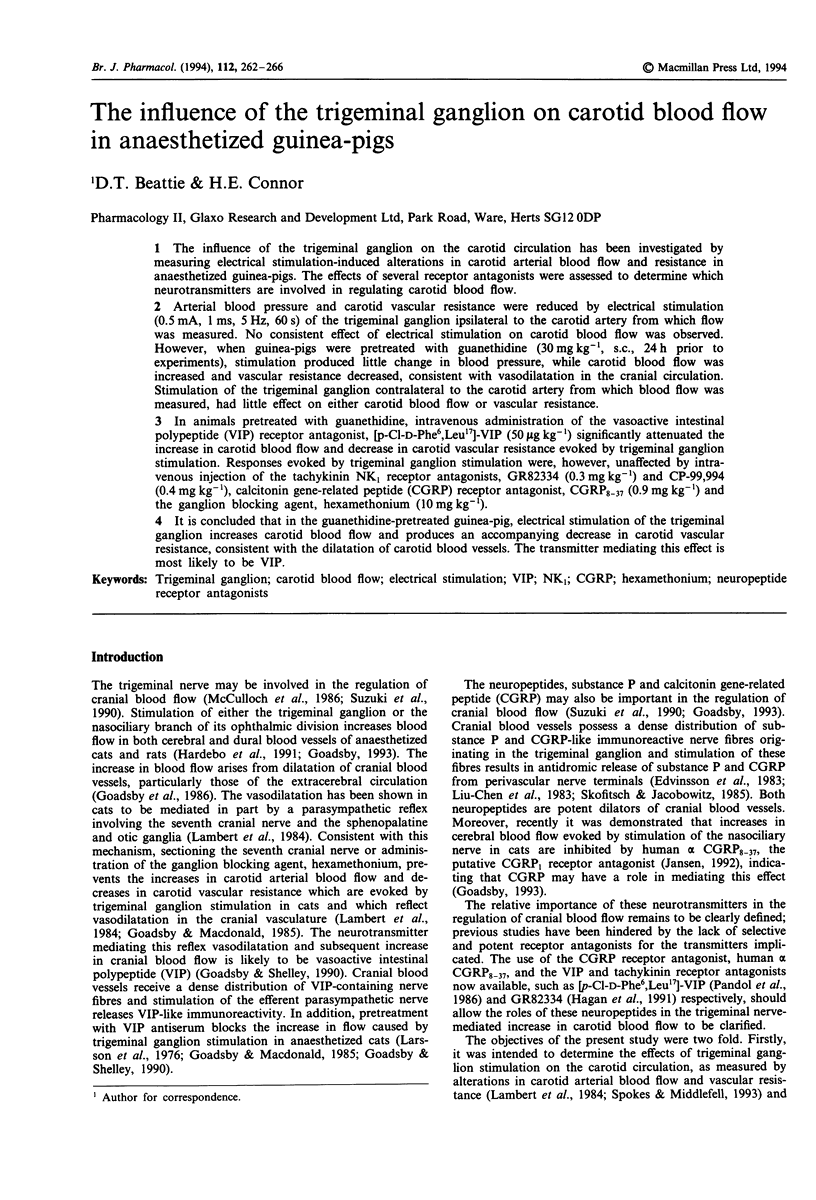
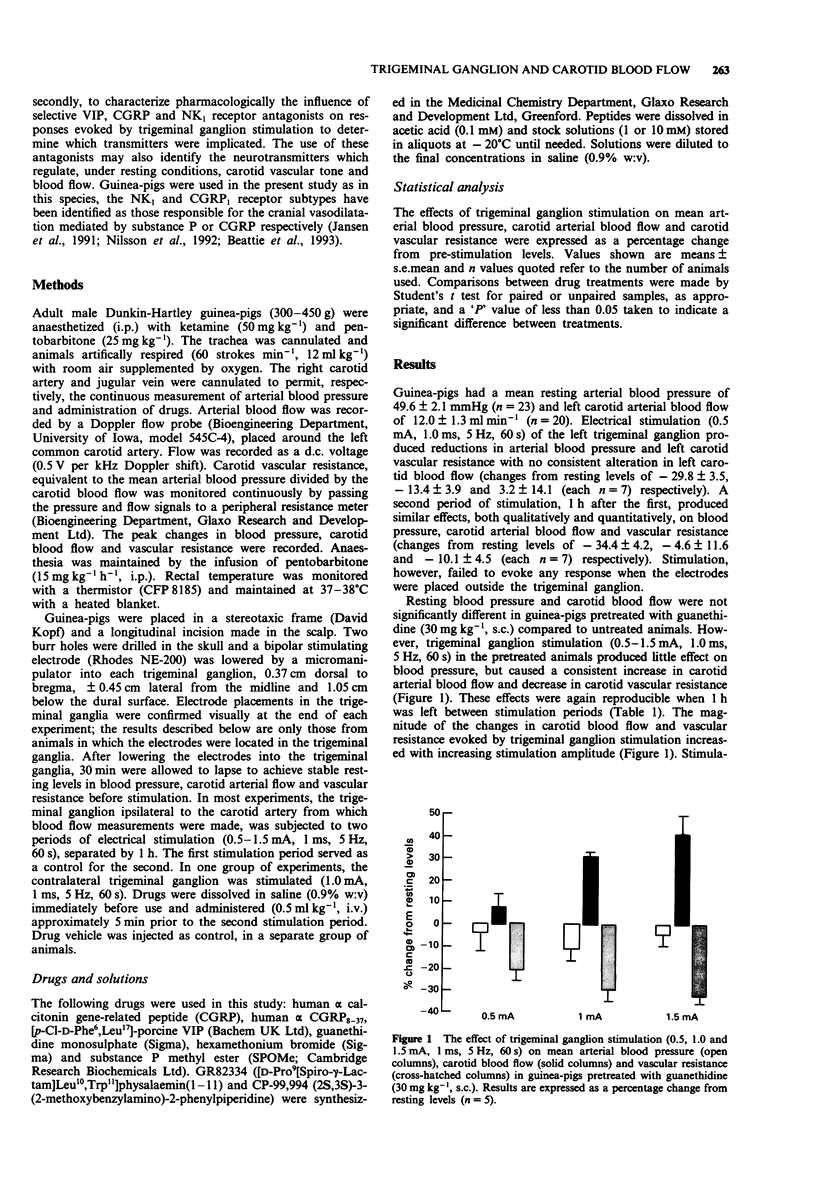
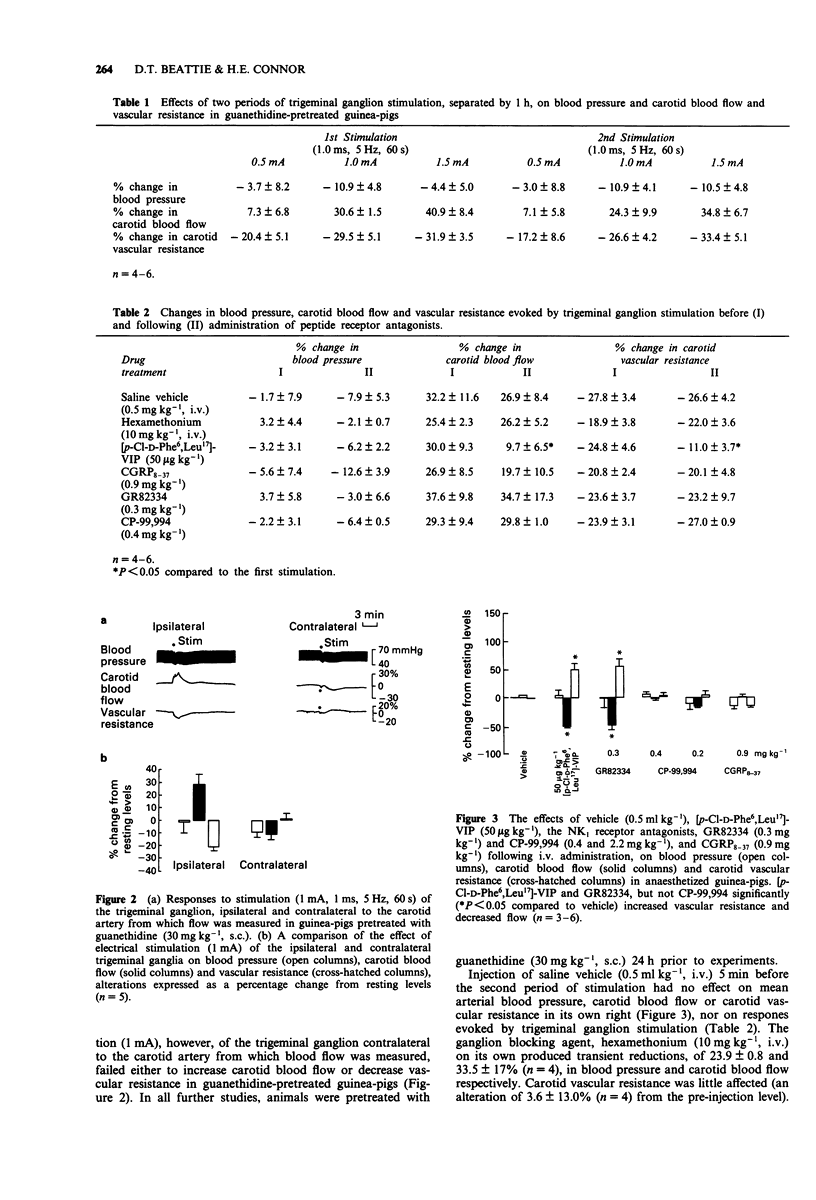
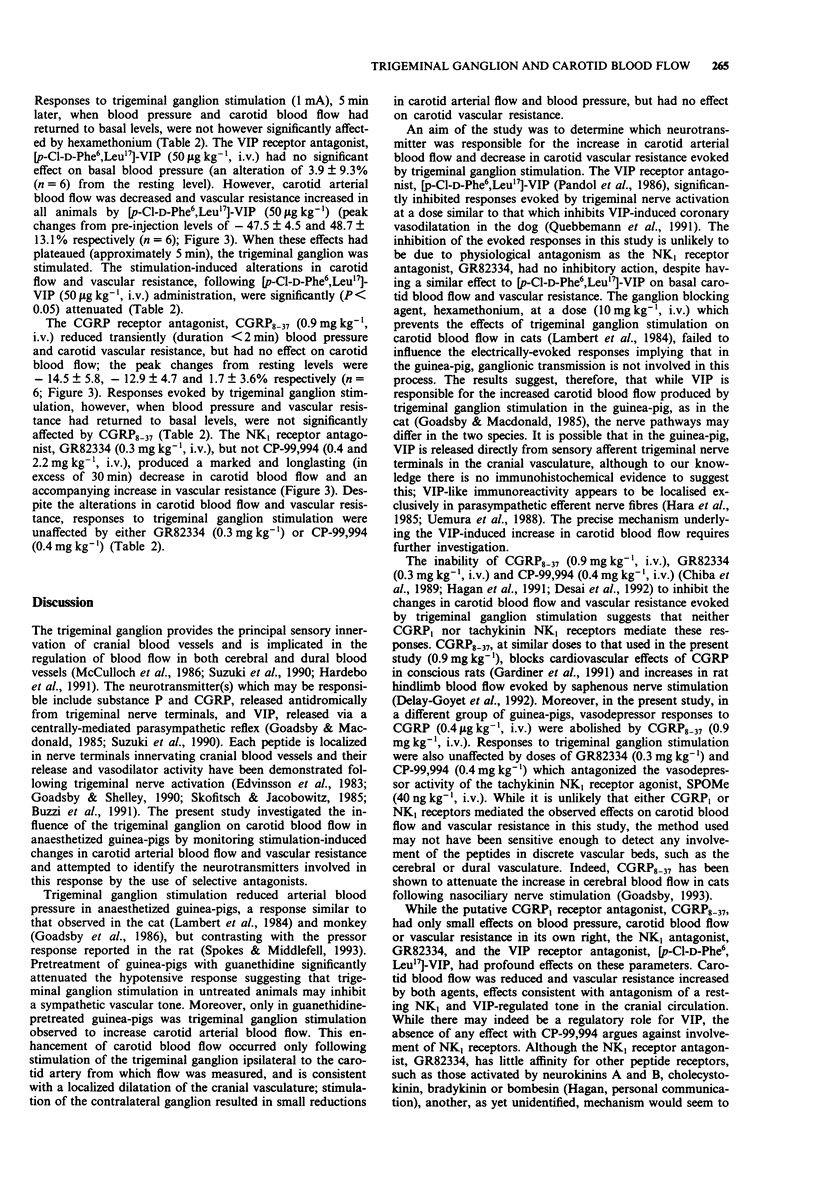
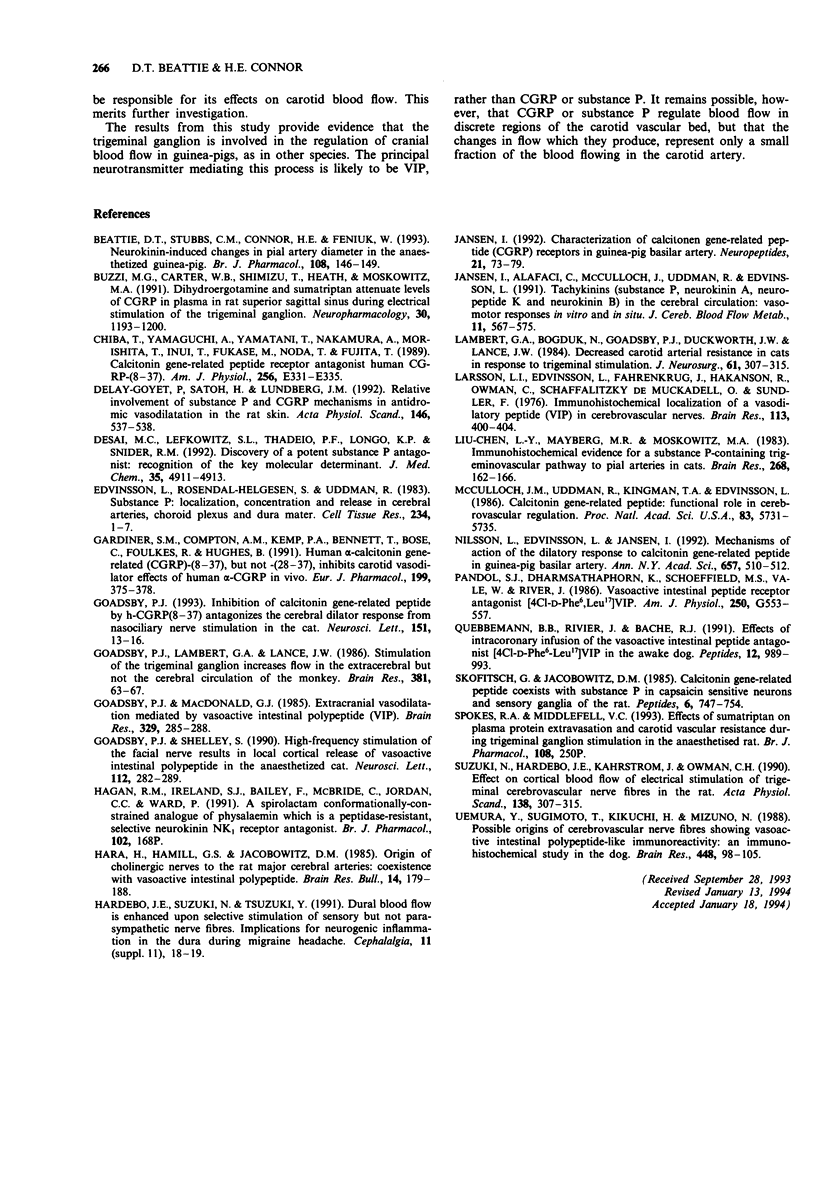
Selected References
These references are in PubMed. This may not be the complete list of references from this article.
- Beattie D. T., Stubbs C. M., Connor H. E., Feniuk W. Neurokinin-induced changes in pial artery diameter in the anaesthetized guinea-pig. Br J Pharmacol. 1993 Jan;108(1):146–149. doi: 10.1111/j.1476-5381.1993.tb13454.x. [DOI] [PMC free article] [PubMed] [Google Scholar]
- Buzzi M. G., Carter W. B., Shimizu T., Heath H., 3rd, Moskowitz M. A. Dihydroergotamine and sumatriptan attenuate levels of CGRP in plasma in rat superior sagittal sinus during electrical stimulation of the trigeminal ganglion. Neuropharmacology. 1991 Nov;30(11):1193–1200. doi: 10.1016/0028-3908(91)90165-8. [DOI] [PubMed] [Google Scholar]
- Chiba T., Yamaguchi A., Yamatani T., Nakamura A., Morishita T., Inui T., Fukase M., Noda T., Fujita T. Calcitonin gene-related peptide receptor antagonist human CGRP-(8-37). Am J Physiol. 1989 Feb;256(2 Pt 1):E331–E335. doi: 10.1152/ajpendo.1989.256.2.E331. [DOI] [PubMed] [Google Scholar]
- Delay-Goyet P., Satoh H., Lundberg J. M. Relative involvement of substance P and CGRP mechanisms in antidromic vasodilation in the rat skin. Acta Physiol Scand. 1992 Dec;146(4):537–538. doi: 10.1111/j.1748-1716.1992.tb09460.x. [DOI] [PubMed] [Google Scholar]
- Desai M. C., Lefkowitz S. L., Thadeio P. F., Longo K. P., Snider R. M. Discovery of a potent substance P antagonist: recognition of the key molecular determinant. J Med Chem. 1992 Dec 25;35(26):4911–4913. doi: 10.1021/jm00104a018. [DOI] [PubMed] [Google Scholar]
- Edvinsson L., Rosendal-Helgesen S., Uddman R. Substance P: localization, concentration and release in cerebral arteries, choroid plexus and dura mater. Cell Tissue Res. 1983;234(1):1–7. doi: 10.1007/BF00217397. [DOI] [PubMed] [Google Scholar]
- Gardiner S. M., Compton A. M., Kemp P. A., Bennett T., Bose C., Foulkes R., Hughes B. Human alpha-calcitonin gene-related peptide (CGRP)-(8-37), but not -(28-37), inhibits carotid vasodilator effects of human alpha-CGRP in vivo. Eur J Pharmacol. 1991 Jul 9;199(3):375–378. doi: 10.1016/0014-2999(91)90504-j. [DOI] [PubMed] [Google Scholar]
- Goadsby P. J. Inhibition of calcitonin gene-related peptide by h-CGRP(8-37) antagonizes the cerebral dilator response from nasociliary nerve stimulation in the cat. Neurosci Lett. 1993 Mar 5;151(1):13–16. doi: 10.1016/0304-3940(93)90033-h. [DOI] [PubMed] [Google Scholar]
- Goadsby P. J., Lambert G. A., Lance J. W. Stimulation of the trigeminal ganglion increases flow in the extracerebral but not the cerebral circulation of the monkey. Brain Res. 1986 Aug 27;381(1):63–67. doi: 10.1016/0006-8993(86)90690-6. [DOI] [PubMed] [Google Scholar]
- Goadsby P. J., MacDonald G. J. Extracranial vasodilation mediated by vasoactive intestinal polypeptide (VIP). Brain Res. 1985 Mar 11;329(1-2):285–288. doi: 10.1016/0006-8993(85)90535-9. [DOI] [PubMed] [Google Scholar]
- Goadsby P. J., Shelley S. High-frequency stimulation of the facial nerve results in local cortical release of vasoactive intestinal polypeptide in the anesthetised cat. Neurosci Lett. 1990 May 4;112(2-3):282–289. doi: 10.1016/0304-3940(90)90217-w. [DOI] [PubMed] [Google Scholar]
- Hara H., Hamill G. S., Jacobowitz D. M. Origin of cholinergic nerves to the rat major cerebral arteries: coexistence with vasoactive intestinal polypeptide. Brain Res Bull. 1985 Feb;14(2):179–188. doi: 10.1016/0361-9230(85)90077-2. [DOI] [PubMed] [Google Scholar]
- Jansen I., Alafaci C., McCulloch J., Uddman R., Edvinsson L. Tachykinins (substance P, neurokinin A, neuropeptide K, and neurokinin B) in the cerebral circulation: vasomotor responses in vitro and in situ. J Cereb Blood Flow Metab. 1991 Jul;11(4):567–575. doi: 10.1038/jcbfm.1991.105. [DOI] [PubMed] [Google Scholar]
- Jansen I. Characterization of calcitonin gene-related peptide (CGRP) receptors in guinea pig basilar artery. Neuropeptides. 1992 Feb;21(2):73–79. doi: 10.1016/0143-4179(92)90517-z. [DOI] [PubMed] [Google Scholar]
- Lambert G. A., Bogduk N., Goadsby P. J., Duckworth J. W., Lance J. W. Decreased carotid arterial resistance in cats in response to trigeminal stimulation. J Neurosurg. 1984 Aug;61(2):307–315. doi: 10.3171/jns.1984.61.2.0307. [DOI] [PubMed] [Google Scholar]
- Larsson L. I., Edvinsson L., Fahrenkrug J., Håkanson R., Owman C., Schaffalitzky de Muckadell O., Sundler F. Immunohistochemical localization of a vasodilatory polypeptide (VIP) in cerebrovascular nerves. Brain Res. 1976 Aug 27;113(2):400–404. doi: 10.1016/0006-8993(76)90951-3. [DOI] [PubMed] [Google Scholar]
- Liu-Chen L. Y., Mayberg M. R., Moskowitz M. A. Immunohistochemical evidence for a substance P-containing trigeminovascular pathway to pial arteries in cats. Brain Res. 1983 May 23;268(1):162–166. doi: 10.1016/0006-8993(83)90402-x. [DOI] [PubMed] [Google Scholar]
- McCulloch J., Uddman R., Kingman T. A., Edvinsson L. Calcitonin gene-related peptide: functional role in cerebrovascular regulation. Proc Natl Acad Sci U S A. 1986 Aug;83(15):5731–5735. doi: 10.1073/pnas.83.15.5731. [DOI] [PMC free article] [PubMed] [Google Scholar]
- Nilsson L., Edvinsson L., Jansen I. Mechanisms of action of the dilatory response to calcitonin gene-related peptide in guinea pig basilary artery. Ann N Y Acad Sci. 1992 Jun 30;657:510–512. doi: 10.1111/j.1749-6632.1992.tb22816.x. [DOI] [PubMed] [Google Scholar]
- Pandol S. J., Dharmsathaphorn K., Schoeffield M. S., Vale W., Rivier J. Vasoactive intestinal peptide receptor antagonist [4Cl-D-Phe6, Leu17] VIP. Am J Physiol. 1986 Apr;250(4 Pt 1):G553–G557. doi: 10.1152/ajpgi.1986.250.4.G553. [DOI] [PubMed] [Google Scholar]
- Quebbemann B. B., Rivier J., Bache R. J. Effects of intracoronary infusion of the vasoactive intestinal peptide antagonist [4Cl-D-Phe6-Leu17]VIP in the awake dog. Peptides. 1991 Sep-Oct;12(5):989–993. doi: 10.1016/0196-9781(91)90048-t. [DOI] [PubMed] [Google Scholar]
- Skofitsch G., Jacobowitz D. M. Calcitonin gene-related peptide coexists with substance P in capsaicin sensitive neurons and sensory ganglia of the rat. Peptides. 1985 Jul-Aug;6(4):747–754. doi: 10.1016/0196-9781(85)90179-2. [DOI] [PubMed] [Google Scholar]
- Suzuki N., Hardebo J. E., Kåhrström J., Owman C. Effect on cortical blood flow of electrical stimulation of trigeminal cerebrovascular nerve fibres in the rat. Acta Physiol Scand. 1990 Mar;138(3):307–316. doi: 10.1111/j.1748-1716.1990.tb08851.x. [DOI] [PubMed] [Google Scholar]
- Uemura Y., Sugimoto T., Kikuchi H., Mizuno N. Possible origins of cerebrovascular nerve fibers showing vasoactive intestinal polypeptide-like immunoreactivity: an immunohistochemical study in the dog. Brain Res. 1988 May 10;448(1):98–105. doi: 10.1016/0006-8993(88)91105-5. [DOI] [PubMed] [Google Scholar]


